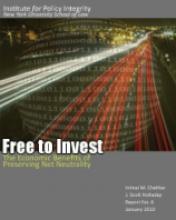
Fast, affordable Internet access for all.


Joanne Hovis, President of CTC Technology and Energy, recently published a must-read article in Broadband Properties Magazine. Whether you are a community leader investigating the possibility of a publicly owned network or an engaged citizen looking for pros and cons, this piece explains practical benefits succinctly. In her article, The Business Case For Government Fiber Networks [PDF], Hovis looks at life beyond stimulus funding. She points out how we should evaluate municipal networks in an environment where shareholder profit is not the first consideration.
Hovis gives a brief history of how local communities reached this point of need. As many of our readers know, local communities used to be able to negotiate with cable providers for franchise opportunities and rights-of-way. Often cable providers would construct broadband infrastructure in exchange for a franchise to operate in a given community, creating I-Nets for local government, schools and libraries. Once states inserted themselves into the process with state-wide franchising, local negotiating power evaporated. Many of those franchise agreements are ending and local leaders are considering municipal fiber optic networks.
Hovis stresses that municipalities do not function in the same environment as the private sector. While they still have a fiscal responsibility to their shareholders (the taxpayers) the main function is providing public safety, encouraging economic development, offering education, and using tax dollars to better the quality of life. Hovis describes how redefining return on investment (ROI) needs to go beyond the balance sheet bottom line.
These benefits have nothing to do with traditional financial measures. Rather, they represent the return to the community in terms of such largely intangible societal benefits as enhancing health care quality, narrowing the digital divide, providing enhanced educational opportunities to school children, delivering job search and placement opportunities at public computer centers and helping isolated senior citizens make virtual social connections.
In the early 1950s, it was nearly impossible to know the value of an automobile. They had prices, yes, but these would differ radically from dealer to dealer, the customer a pawn in the hands of the seller. This all changed in 1958, when US senator Mike Monroney of Oklahoma shepherded a bill through Congress requiring that official pricing information be glued to the window of every new automobile sold in the US. The “Monroney sticker,” as it came to be known, has been with us ever since. It became an effective means of disclosing the manufacturer’s suggested retail price, or MSRP, and a billboard for other data disclosures to the consumer: the car’s fuel economy, its environmental rating, and so on. The sticker price was one of the triumphs of consumer-rights legislation and has made buying a car an easier—though never altogether easy—experience. What’s more, window stickers made automobile pricing rational and understandable. A customer who knows the base price going in will expect more value coming out. In economic terms, the sticker turned a failed market flummoxed by information asymmetry into something resembling a functioning, price-driven marketplace.There are many smart government policies that could radically improve the telecommunications industry, collectively saving billions of dollars for Americans and businesses. Unfortunately, most of these policies have been ignored by Congress and the FCC, which have focused instead on the solutions put forth by the big cable and DSL companies to further their own narrow interests.

In 2010, the Institute for Policy Integrity at the New York University School of Law released a report titled Free to Invest: The Economic Benefits of Preserving Net Neutrality. The report, authored by Inimai Chettiar and J. Scott Holladay, is a great resource - substantial and very digestible - on what net neutrality really is, how it is (or is not) regulated, and the economic possibilities policy makers must consider when moving ahead.
The Institute looks at the economic relationships between content providers, ISPs, and consumers. In addition to the current economic structure, the report examines possible alternate pricing models that are contrary to our current net neutrality policies. We have extracted just a few excerpts and encourage you to get the full report.
There are five main findings that are examined in depth:
Internet Market Failure: The report explains how ISPs lose potential dollars under today's market structure. There is ample motivation for them to find a way to charge content providers based on delivery, and open up a whole new market far beyond our net neutrality policy.
The FCC’s nondiscrimination rule would prohibit an ISP from treating any content, application, or service in a “discriminatory” manner, subject to reasonable network management. This clearly bans pure price discrimination (charging different content providers different prices to access their subscribers). The regulation also bans ISPs from offering content providers a “take it or leave it” offer on access to their users. For example, an ISP like Verizon could not charge a website of a company like The New York Times a certain price for access to its subscribers by threatening to block the website from its network and therefore from its Internet subscribers.
Smart Policy Can Help: The authors of the report stress how the Internet must be viewed as a two pronged market - infrastructure to deliver the content and the content itself - and how both are equally important. Effective policy must recognize the delicacy of that balance.
Before the economic downturn, a typical small video service provider could expect between $1.25 and $2.00 a month per subscriber in ad revenues, noted Walter P. Staniszewski, president of Prime Media Productions – a company that sells advertising for small video service provider clients. Since the downturn, the numbers are more like $1.00 to $1.50.The article focuses on the windfall cable operators are seeing due to all the money being spent by big-money interests in anticipation of the election in November. However, the smallest networks may not want to commit to ad-insertion until they are reaching thousands of homes, according to the Telecompetitor source:
“If you study the cable industry, even the big guys didn’t have their own sales force until they developed some real scale,” said Staniszewski. He cautioned operators with systems with fewer than 5,000 or 6,000 subscribers against hiring their own sales force.
Lesson 1: Google built its own network. It isn't leasing connections or services from big telecommunications companies. Building your own network gives you more control -- both of technology and pricing. Lesson 2: Google uses fiber-optics. These connections are reliable and have the highest capacity of any communications medium. The homes in Kansas City are connected via fiber whereas Time Warner Cable, CenturyLink, and others continue to rely on last-generation technologies because they are delaying investment in modern technology to boost their profits.
 Others have already followed these lessons but are not able to offer their gig for such a low prices. To understand why, let's start with some basics. I'm hypothetically starting Anytown Fiber Net in my neighborhood and I want to offer a gig.
Others have already followed these lessons but are not able to offer their gig for such a low prices. To understand why, let's start with some basics. I'm hypothetically starting Anytown Fiber Net in my neighborhood and I want to offer a gig.
 #6 is a great explanation of why communities should directly invest in broadband. Local economic growth and secondary investment enabled by broadband expansion is 10 times the initial investment.
Think about that. While private companies have long built, owned, and operated most of the broadband networks, they have seriously underinvested. They underinvest because they cannot monetize many of the benefits from broadband. Faster, more reliable connections simply do not translate into more revenue for cable and telephone companies. So the big incumbents have largely ceased investing in next-generation networks.
These massive corporations do not care about the growth of secondary investments or other spillover effects from better broadband in communities because it does not change their bottom line -- the one thing they are supposed to prioritize over all other matters.
This is why communities should be investing in themselves. Communities do care about secondary investments and spillover benefits from broadband. In fact, they are specifically tasked with investing to benefit the community!
So when it comes to maximizing the benefits of broadband, community investments tend to make a lot of sense... and other secondary benefits.
#6 is a great explanation of why communities should directly invest in broadband. Local economic growth and secondary investment enabled by broadband expansion is 10 times the initial investment.
Think about that. While private companies have long built, owned, and operated most of the broadband networks, they have seriously underinvested. They underinvest because they cannot monetize many of the benefits from broadband. Faster, more reliable connections simply do not translate into more revenue for cable and telephone companies. So the big incumbents have largely ceased investing in next-generation networks.
These massive corporations do not care about the growth of secondary investments or other spillover effects from better broadband in communities because it does not change their bottom line -- the one thing they are supposed to prioritize over all other matters.
This is why communities should be investing in themselves. Communities do care about secondary investments and spillover benefits from broadband. In fact, they are specifically tasked with investing to benefit the community!
So when it comes to maximizing the benefits of broadband, community investments tend to make a lot of sense... and other secondary benefits. The city will order 5,000 additional set-top boxes for Fibrant at the discounted price of $721,572… Fibrant’s original inventory of 5,000 set-top boxes purchased in March 2010 is running low, Behmer said. The city’s new broadband utility, which sells Internet, cable TV and phone services to Salisbury residents, has about 1,200 customers and averages about three set-top boxes per home, he said.This is a reminder of the economics of these networks. Each set-top box costs something like $150. Household that subscribes for television service average 3 set-stop boxes, meaning that the cost of those boxes alone is about $450 of loss to Fibrant before the subscriber pays a dime to Fibrant. This is why muni networks take so long to break even. The additional install costs like the equipment on the side of the house and the labor to set everything up grow quickly -- often to between $1200-$1500 per subscriber. It takes years to pay down those costs, plus the interest of borrowing to build the network. So when you hear that a community network is running in the red in year 3, you should say, "Duh." Infrastructure often takes a long time to pay off, which is one of the main reasons the private sector does such a poor job of providing it.
SoverNet will own the infrastructure but is required to provide bandwidth at wholesale cost to providers who extend the service outward. Loredo Sola is skeptical. He says he's already lost one institutional contract to the SoverNet project. He says that's forced E.C. Fiber to scrap its plans to serve smaller users in the area.Sovernet is building a middle mile network connection community anchor institutions, but is an example of the exact wrong way to do it. Supposedly, the investment (the vast majority of which is funded by a federal stimulus award) will allow more ISPs to build more last mile networks as they have access to better backhaul. But lowering the operating cost of a network does very little to make that network affordable to build. The high up front capital costs are what limit broadband in rural (and urban too!) areas.